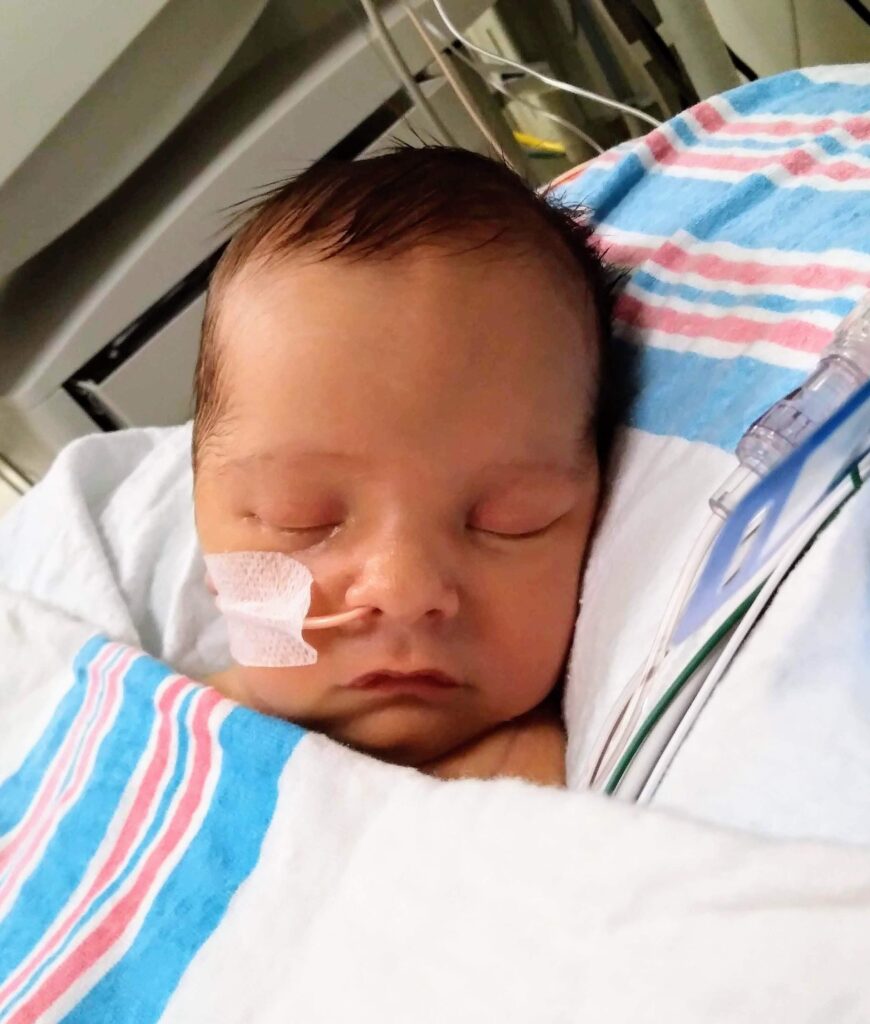
Name: Emily and Matt Driggers
Location: Georgia, United States
Child’s Birth Year: 2021
Keywords: Loss Parent, HIE Dad, Navigating Grief, Supporting Your Partner, Challenges During COVID-19
Emily and Matt live in Atlanta, Georgia, with their daughter, Nora, who was born in 2017. After their son, Lewis, was born in February of 2021, they never envisioned that they would say goodbye two weeks later. They never envisioned that Nora would never have the chance to physically meet her baby brother. They never envisioned that the range of human emotions could be so wide and intense. And yet, they never envisioned that their greatest loss could also serve as an impetus for growth and connection.
Up until the very end, there were no issues with Emily’s pregnancy. At around thirty-five weeks, Emily felt Lewis stop moving. The stillness was atypical for her otherwise mobile boy, so Emily went to the doctor for a check-up. Lewis’ heart rate was elevated, and after it had not gone back down after a day, Emily was taken for an emergency C-section.
When Lewis came out, he seemed very stiff, and he didn’t have some of the expected reflexes. No one knew what was going on, as everything had appeared “normal”—the placenta was healthy and there were no umbilical cord issues. The first few days at the lower-level NICU were marked by a search for even a hint of a diagnosis. Hope ebbed and flowed over the course of days and sometimes hours, with Emily and Matt attempting to retain optimism where they could find it while also being realistic. After Lewis’ initial MRI, Emily and Matt were told that nothing remarkable was found. It was frustrating not being any closer to a diagnosis, to any answers, or to an image of what life would look like down the road.
The conflicting thoughts and emotions that Emily and Matt experienced added to this confusion. They tried their best to hold onto the mindset that regardless of what happened, they were still Lewis’ parents….the only thing they could do was be his parents, trying to connect with him in whatever way possible. They continued to read books to Lewis despite not knowing what sensory input he was capable of processing, for every effort at bond-forming and memory-making is worthwhile. And yet, in those same moments, it felt impossible to not be angry at the world, lamenting over why this happened to them and their child.
In the midst of unrelenting ambiguity, Emily and Matt sought a second opinion on Lewis’ MRI. This time around, a week and a half after Lewis’ birth, they finally found that hint they were searching for. A pediatric neurologist affiliated with a higher-level NICU informed them that Lewis most likely had hypoxic ischemic encephalopathy. To hear those words was bittersweet—it felt comforting to now at least have keywords to type into Google, but it was devastating to consider the possibility that Lewis might fall on the severe end of the spectrum of outcomes.
While they had some semblance of a diagnosis, Emily and Matt still had no idea what Lewis’ HIE meant in terms of prognosis. They were fortunately able to get plugged into Hope for HIE early on, but with the future being so uncertain, they didn’t know which resources were relevant and which were irrelevant for their situation. Should they apply for early intervention services? Would they be taking care of a child at home who had challenges with functions such as swallowing and still be alive, or would Lewis not make it out of the hospital? Especially in the beginning stages, the doctors avoided putting death on the radar. Though Emily and Matt understood this position—the doctors didn’t want to crush optimism prematurely—they wished they were given an indication further upstream that Lewis was a severe case. If they had known that Lewis’ complications from HIE were not things he would just “snap out of” or recover from, perhaps they could have prepared for what was to come.
Yet, how do parents prepare for the death of a child and the ocean of grief that comes with it? How do parents grapple with the loss of the future they pictured for their family? When Lewis died in the NICU at two weeks old due to issues with his heart rate and breathing, Emily and Matt learned that there was no singular boat perfectly designed to navigate the rough waters of grief and loss. All they could do was allow themselves to express their waves of emotions instead of suppressing them under the surface. Whether they felt grateful or bitter, hopeful or devastated, Emily and Matt accepted that all their feelings were worthy of being expressed and shared with the people around them.
Because Lewis was born during the COVID-19 pandemic, no one else in the family—not even Nora—was able to meet him in person. To Emily and Matt, the two weeks in the NICU felt like a fever dream that they had experienced in silos, isolated from the rest of their world. So, connecting with other loss parents and gaining a sense that they were not actually alone was a huge source of hope. What also instilled hope in them was realizing how many parents out there dealing with disability on one level or another were advocating to give their children the best lives possible. Emily and Matt were also thankful for the friends and family that helped them during the NICU stay and afterwards, both logistically and emotionally. When they mentally were not ready to go grocery shopping or needed help with child care for Nora, their loved ones stepped right in. Emily wanted to share Lewis’ story so that others knew he existed and that his impact transcended time—her loved ones were there to listen. Matt went through a phase where he began closing off to people because he didn’t think they could relate with what he had endured—his loved ones, especially Emily, gave him the space to grieve in his own way.
Most of all, Emily and Matt were grateful for Lewis, their beautiful baby boy. Lewis showed Emily and Matt how much love they hold inside themselves and how much love exists out in the world. Part of the gift of Lewis was how much it opened the doors to people they would never have otherwise met or reconnected with. The experience with HIE was an intense, concentrated period of growth where Emily and Matt were forced to consider their answers to questions such as who they are as people, what matters most in life, how to define hope, and what circumstances they are able to face and cope with.
Emily and Matt are proud that they have not only survived, but are growing as parents and individuals in the wake of immense loss. Emily and Matt were right by Lewis’ side the whole time, holding him in his final moments and trying their best to remain present in one of the most painful experiences of their lives. They continue to remain present for each other and for Nora. It wasn’t fair that Nora had to begin to piece together what death means at the mere age of three, but Emily and Matt made sure to not leave Nora in the dark. The anticipation of becoming a big sister had been a large part of Nora’s life, so it didn’t feel right to exclude Nora from discussions about Lewis in an attempt to shelter her. Instead, after Lewis’ death, Emily and Matt put pictures up of him around the house, explaining to Nora that even though Lewis was gone, they all still loved him. They reminded her that it was okay to feel sad at times.
Emily and Matt never would have believed it if someone told them they’d be able to reconceptualize Lewis’ short time on Earth as a gift. They never would have believed that they could find hope and a path forward in the aftermath of tragedy. Nonetheless, here they are, continuing to share their story so that other HIE families can have resources they wished they were provided with during their time in the NICU. Here they are, continuing to hold onto the love they have for Lewis and recognizing the love they could grow for another child. Here they are, sometimes mournful and other times content, sometimes distressed and other times at peace.

Connect with families, read inspiring stories, and get helpful resources delivered right to your inbox.